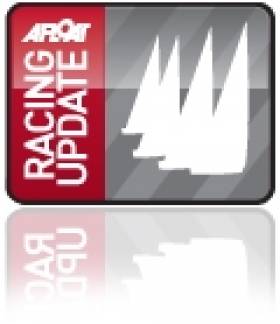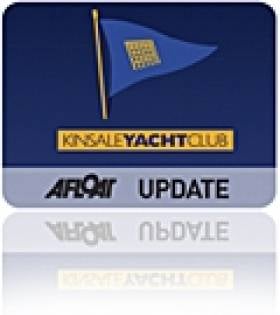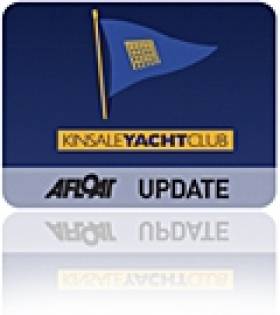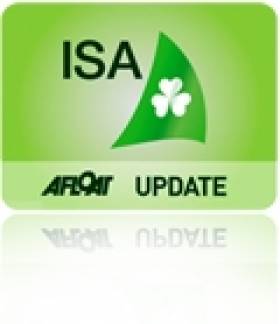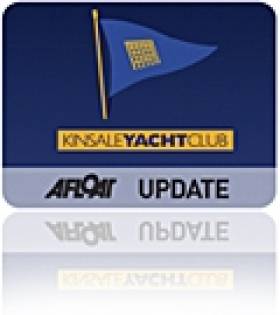Displaying items by tag: Kinsale Yacht Club
Racing update: DBSC, ISORA, Royal St. George Knights, Olympic Keelboat Drama and Kinsale's Club House
Abroad, Keelboats are out of the Olympic Games (and kitesurfing is in!). Royal St. George Knights were quarter finalists at the British Team Racing Champs. There is video too with Irish commentator Jimmy Fitzpatrick.
Should Kinsale Yacht Club move or rebuild a crumbling premises?
KYC Meets on Clubhouse Situation
Kinsale Yacht Club (KYC) held an information meeting last Tuesday to discuss the situation of its aging clubhouse ahead of a planned EGM later this month.
Structural problems were previously discussed at a club meeting last November, at which a number of options were presented.
These included undertaking a complete refurbishment of the building, and the option of moving the club to a new green field site on the other side of the River Bandon.
Tuesday's meeting at KYC saw presentations from an engineer, an architect, a quantity surveyor and an expert financial advisor based on these options, in order to evaluate the best choice for the club going forward - namely the first option of refurbishing.
The club committee will propose a motion to adopt its recommendation to move ahead with refurbishment plans at the EGM, scheduled for Tuesday 24 May at 8pm.
Sovereigns Cup Aiming for 140 Entries
Entries are coming in at a good pace for The Sovereign's Cup the South coast sailing event takes place from 22nd-25th June 2011 in the outer harbour of Kinsale, Co Cork.
"We are delighted with the entry level to date and are now encouraging boats to enter The Sovereign's Cup on our website www.sovereignscup.com or by calling Kinsale Yacht Club directly on (021) 4773433. Already, skippers are beginning to plan their sailing events for the year and we hope that they will favourably consider us here in Kinsale," said Gary Horgan, Regatta Director.
"Additionally, this year, the Dun Laoghaire to Dingle race and ICRA Championships in Cork just before The Sovereign's Cup should act as good feeders as boats will be down south. As well as the excellent sailing conditions, race management and social programme ashore, there is a good discounted entry fee for the first 100 entries, which is already proving very attractive to entrants. Also, we are encouraging people to start thinking about their travel and accommodation plans and are delighted that the Cork Swansea ferry will enable more sailors to access Kinsale easily from the UK," he added.
The Sovereign's Cup was established in 1995 as and has been a very successful and hugely popular cruiser regatta. The biennial event attracts over 140 boats from all over Ireland and the UK who compete for the prestigious Sovereign's Cup for best all round score in IRC and The Portcullis Trophy for best progressive handicap.
There are many Classes for entry; including Class 0, 1, 2, 3, 4 and two White Sails classes. Also, the Quarter Ton Class Championships will be taking place during the Sovereign's Cup, bringing many new visitors to Kinsale from the South of England and Wales in particular.
According to Ian Travers of the Sovereign's Cup Committee at KYC, interest has been phenomenal and he has received plenty of calls from UK and Irish owners expressing their interest.
"Also, I have received confirmation that a quarter tonner named 'Black Fun' is to be shipped from New Zealand to Europe this year and is intent on making it to Kinsale for the Sovereign's Cup! We are confident that there will be around 25-30 quarter tonners participating in the Sovereign's Cup this year," said Ian Travers.
For more information on The Sovereign's Cup, contact Kinsale Yacht Club on (021) 4773433 www.kyc.ie or www.sovereignscup.com
Take a look back at Bob Bateman's photos from Sovereigns Cup 2003, Sovereigns Cup 2005 and Sovereigns Cup 2007 in our photo reviews
Click this link for all the lastest Sovereigns Cup news from Afloat.ie
All Ireland Champs Move to Kinsale
The re-run of the All Ireland Sailing Championships will take place in Kinsale and not Crosshaven on November 20th according to a press release from the Irish Sailing Association published today.
A minimum of three races must be completed for the competition to conclude and the ISA Helmsman's Trophy awarded.
The final, originally scheduled to take place in Royal Cork Yacht Club on the 26th of September, had to be abandoned due to an absence of wind.
The competition will be sailed in the ISA SailFleet J80's which are currently based in Kinsale Yacht Club. Due to the difficulty in safely sailing the fleet from Kinsale to Crosshaven the venue had to be changed, however the host club remains Royal Cork Yacht Club who are now kindly assisted by Kinsale Yacht Club.
8 teams will be competing for the ISA Helmsmans Trophy. As this competition is recognised as a new event, no previous points shall be carried forward. Each competitor begins with a blank score card.
The finalists are:
Anthony O'Leary
Ewen Barry
Garrett May
James Espey
Neil Kenefick
Niall Henry
Nicholas O'Leary
Nick Walsh
Who'll win? We're starting a readers poll on Monday. Click back to cast your vote!
Kinsale Yacht Club Announces 2011 Sovereign's Cup
Details of the 2011 Sovereign's Cup were announced at a reception at Kinsale Yacht Club, hosted by Regatta Director, Gary Horgan. The Sovereign's Cup takes place from 22nd-25th June 2011 in the outer harbour of Kinsale which prides itself with excellent sailing conditions, as well as an extensive social programme ashore.
The Sovereign's Cup was established in 1995 as a biennial event and has been a very successful and hugely popular cruiser regatta, with over 140 boats from all over Ireland and the UK competing for the prestigious Sovereign's Cup for best all round score in IRC and The Portcullis Trophy for best progressive handicap.
There are many Classes for entry; including Class 0, 1, 2, 3, 4 and two White Sails classes. Also, the Quarter Ton Class Championships will be taking place during the Sovereign's Cup, bringing many new visitors to Kinsale from the South of England and Wales in particular.
Eamonn Rohan in Blondie IV a Mills Design King 40, claimed the 2009 Sovereign's Cup as the 2009 Portcullis Trophy was awarded to Chapman / Reilly's Crazy Horse. Anchor Challenge captured Class 3-IRC and the Quarter Ton Class and was awarded the Keane's Jewellers Quarter Ton Perpetual Trophy.

The Kinsale Yacht Club committee behind the 2011 Sovereigns Cup
"We have already received a number of entries for The 2011 Sovereign's Cup in June and we will be stepping up our sponsorship and communications programme as the months advance," said Gary Horgan, Race Director. "We are very grateful to Kinsale Yacht Club, the Race Management team and all the volunteers who get involved with the organisation of the Sovereign's Cup as we are working hard to organise an excellent programme both on and off the water. We are encouraging people to start thinking about their travel and accommodation plans and are delighted that the Cork Swansea ferry will enable more sailors to access Kinsale easily from the UK," he added.
Dragons Prepare for South Coasts in Kinsale
Kinsale Yacht Club hosts the Irish Dragon South Coast Championships from 10 - 12 September 2010.
A very competitive fleet of 18 Dragons will assemble in Kinsale this weekend for the final Championship of the Irish calendar with both the South Coast title and
valuable ranking points for both the World and European Championship qualification on offer.
Though this is a helmsman's championship the importance of an established and cohesive crew on a Dragon is crucial when determining favorites. Neil Hegarty, Peter Bowring and David Willams (Phantom) have excelled on the waters under the Old Head in recent years taking two consecutive National Championships in 2007 and 2009. However, they have always been pushed hard by Martin Byrne (Jaguar) who won the last edition of the South Coast Championships held in Kinsale in 2008 with his son Conor and constant collaborator Pedro De Andrade. Along with several other stellar teams from both the Royal St George and the Royal Irish, including current National Champion Don O'Donoghue (Seabird), is perennial favorite Simon Brien (Kin) from the Royal North of Ireland.
Kinsale Yacht Club has been selected to host the Dragon Gold Cup 2012 and the Kinsale Dragon fleet will be hoping to end the Dun Laoghaire domination of
recent years.
Olaf Sorensen, Martin Payne and Shawn Kingston (Christianna) will lead the challenge with Cameron Good, Henry Kingston and Simon Furney (Little Fella) another long-established team pushing hard for a breakthrough this year. Class Captain Anthony O'Neill with Donal Small and his son Eoghan (Tenacious) have sailed consistently well this season however; Tim Cronin, Caroline Matthews and Harry Lewis (Jee) have found a rich vein of form following a prolonged lay-off and could prove the surprise package.
The courses will be Windward-Leeward and six races will be sailed, with two races each day back to back. Friday promises very interesting conditions with fresh to strong southwesterly winds though the breeze set to moderate throughout the weekend. Principal Race Officer Alan Crosbie and his team will commence proceedings on Friday morning with another scintillating Dragon regatta in prospect.
- Martin Byrne
- Kinsale Yacht Club
- Irish Dragon South Coast Championships
- Neil Hegarty,
- Peter Bowring
- David Willams
- Pedro De Andrade
- Don O'Donoghue
- Simon Brien
- Olaf Sorensen
- Martin Payne
- Shawn Kingston
- Tim Cronin
- Caroline Matthews
- Harry Lewis
- Alan Crosbie
- Henry Kingston
- Cameron Good
- Simon Furney
- Dragon Gold Cup 2012
Kinsale Teenagers Go Offshore on Mercy Mission
The keen sailors, most of whom have just finished their exams, will be sailing a 39ft yacht round the coast of Ireland over six days in August, to raise money for the international charity, Mercy Ships. The charity provides free medical and humanitarian aid to the poorest countries in Africa via its 500ft hospital ship, the Africa Mercy. It is the first time any of the youngsters have undertaken such a challenge and their training starts this week at the Kinsale Yacht Club, where they will familiarise themselves with the yacht Sonas kindly supplied to them for the challenge by its owner David Ross
Ben Fusco, 19, from Kinsale, said, "We are all keen sailors and wanted to combine our love of sailing with doing something for charity. There are lots of great maritime related charities out there but when we heard about the work of Mercy Ships, we were taken by the idea that a ship provides free medical care to some of the poorest people in the world.
"Hearing that thousands of people every year are given free medical care by volunteers on the ship was inspiring and we knew we had to do something special to raise money for them – hence our Round Ireland Challenge.
More on the forum thread started by Ben Fusco HERE.


























